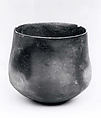Beaker
Not on view
This cup has a narrow base, thin walls, and straight sides. It is made of a dark gray clay which has been burnished. Wheel lines on the inside indicate that it was made on a potter’s wheel.
This cup was excavated at Tepe Hissar, near the modern city of Damghan in northern Iran. Tepe Hissar was primarily an agricultural settlement, with buildings made of mudbrick or simply mud walls. Archaeobotanical remains from the site indicate that the people living there grew wheat, barley, olives, grapes, lentils and other legumes. This cup probably belongs to the Hissar IIIB period, dating to ca. 2400-2170 B.C. on the basis of radiocarbon dating. During this period there was a technically proficient ceramic industry at the site, producing well-formed vessels with thin walls. Although they featured no painted decoration like the earlier vessels from the site, they were burnished to create a glossy, almost shiny surface. But it is not known what these vessels were used for. Similar cups were found in graves, and indeed most of the graves at Tepe Hissar contained cups, suggesting that drinking played a significant role in life, or death, there.
Due to rights restrictions, this image cannot be enlarged, viewed at full screen, or downloaded.

